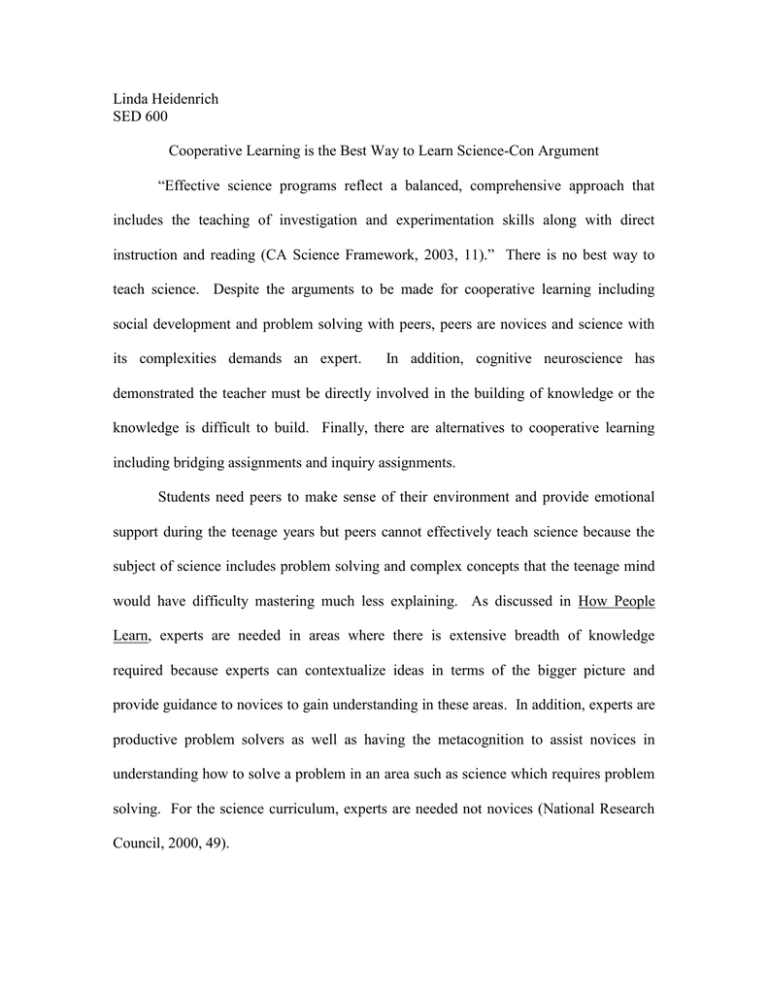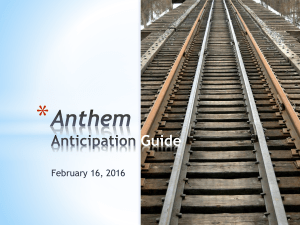Panel: Cooperative Learning: CON
advertisement

Linda Heidenrich SED 600 Cooperative Learning is the Best Way to Learn Science-Con Argument “Effective science programs reflect a balanced, comprehensive approach that includes the teaching of investigation and experimentation skills along with direct instruction and reading (CA Science Framework, 2003, 11).” There is no best way to teach science. Despite the arguments to be made for cooperative learning including social development and problem solving with peers, peers are novices and science with its complexities demands an expert. In addition, cognitive neuroscience has demonstrated the teacher must be directly involved in the building of knowledge or the knowledge is difficult to build. Finally, there are alternatives to cooperative learning including bridging assignments and inquiry assignments. Students need peers to make sense of their environment and provide emotional support during the teenage years but peers cannot effectively teach science because the subject of science includes problem solving and complex concepts that the teenage mind would have difficulty mastering much less explaining. As discussed in How People Learn, experts are needed in areas where there is extensive breadth of knowledge required because experts can contextualize ideas in terms of the bigger picture and provide guidance to novices to gain understanding in these areas. In addition, experts are productive problem solvers as well as having the metacognition to assist novices in understanding how to solve a problem in an area such as science which requires problem solving. For the science curriculum, experts are needed not novices (National Research Council, 2000, 49). Much studying of the brain has occurred in the last several years and the results attained demonstrate the need for a teacher to be the central figure in a science classroom, not their peers. In her study relating cognitive neuroscience and the classroom, Janet Phillips explains how the brain functions best when several conditions are being met; the students need information chunked as they are absorbing the larger picture and students need the information to be made relevant to them (Phillips, 2005, 13). Peers do not have the ability to provide the big picture involved to make sense of the content because they themselves have not been exposed to the big picture and, therefore, it is unfair to rely on peers to provide appropriate context. In addition, depending on the makeup of the cooperative learning group, some students can move at a quicker pace and would not chunk the information at an appropriate pace for all students to gain required knowledge. If the teacher is controlling the classroom, s/he can provide appropriate chunks of information for all students to be successful. Although peers can be effective at making information relevant, the teacher can often be more effective because s/he can make the information relevant in terms of past, present and future in contrast to peers who can only make the content relevant in the present. There are viable and positive alternatives to cooperative learning in which the students are engaged, interacting with the content and making the information relevant to them without using their peer group. The most effective alternative is a process entitled model-based inquiry as proposed in How Students Learn: Science in the Classroom. This method uses the students’ lives to generate projects and discussion items relevant to the students. The projects discussion items are then used to understand a curricular topic. The example given in How Students Learn refers to a genetics unit in a high school biology class. The students read an edited version of Mendel’s paper regarding his work with pea plants to gain background knowledge. The students then created pedigrees of a disorder in their family (National Research Council, 2005, 529). The pedigrees were used to understand the content standards relating to genetics, including how to read a pedigree and understand its significance, how to determine the inheritance patterns of traits and understand how some disorders may have special circumstances, such as sex-linked or multiple alleles. The students do not work with each other to access the knowledge but instead the teacher accessing their prior knowledge and makes the content relevant to them. Works Cited Bransford, John D. & Ann L. Brown (Eds.). (2000). How People Learn: Brain, Mind, Experience and School. Washington D.C.: National Academies Press. Bransford, John D. & M. Suzanne Donovan (Eds.). (2005). How Students Learn: Science in the Classroom. Washington D.C.: National Academies Press. California Department of Education. (2003). Science Framework for California Public Schools. Sacramento, CA. Phillips, Janet (2005). From Neurons to Brainpower: Cognitive Neuroscience and Brain Based Research. Washington D.C.: Office of Educational Research and Improvement. (ERIC Document Reproduction Service No. ED490546)
